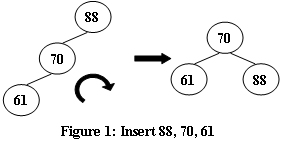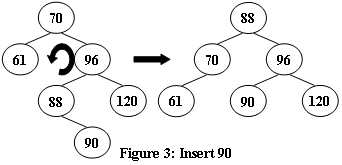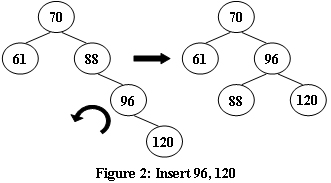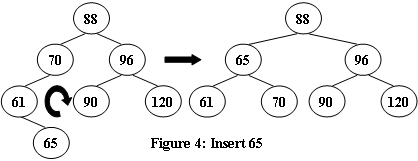An AVL tree is a self-balancing binary search tree. In an AVL tree, the heights of the two child subtrees of any node differ by at most one; if at any time they differ by more than one, rebalancing is done to restore this property. Figures 1-4 illustrate the rotation rules.


Now given a sequence of insertions, you are supposed to tell the root of the resulting AVL tree.
Input Specification:
Each input file contains one test case. For each case, the first line contains a positive integer N (≤20) which is the total number of keys to be inserted. Then N distinct integer keys are given in the next line. All the numbers in a line are separated by a space.
Output Specification:
For each test case, print the root of the resulting AVL tree in one line.
Sample Input 1:
5
88 70 61 96 120
Sample Output 1:
70
Sample Input 2:
7
88 70 61 96 120 90 65
Sample Output 2:
88
Author: 陈越
Organization: 浙江大学
Time Limit: 400 ms
Memory Limit: 64 MB
Code Size Limit: 16 KB
平衡二叉树AVL树的定义是左边的高度和右边的高度不超过1(<=1),为了维持二叉搜索树的平衡性,常见的操作有四种,左单旋,右单旋,左右旋,右左旋
如果插在二叉树的左子数,即小于二叉树的值
需要左旋的情况是,GetHeight(T->Left) - GetHeight(T->Right) == 2 // GeiHegiht返回当前节点的高度
如果此时X < T->Left->Data,则是左单旋
否的话,就是左右双旋
如果插在二叉树的右子数,即大于二叉树的值
且满足GetHeight(T->Left) - GetHeight(T->Right) == -2 需要右旋
如果X > T->Right->Data ,右单旋即可,若否,则需要右左双旋
#include <stdio.h>
#include <stdlib.h>
#define ElementType int
typedef struct AVLNode *Position;
typedef Position AVLTree; /* AVL树类型 */
struct AVLNode {
ElementType Data; /* 结点数据 */
AVLTree Left; /* 指向左子树 */
AVLTree Right; /* 指向右子树 */
int Height; /* 树高 */
};
int Max(int a, int b)
{
return a > b ? a : b;
}
int GetHeight(AVLTree A) {
if (!A)
return -1;
return A->Height;
}
AVLTree SingleLeftRotation(AVLTree A)
{ /* 注意:A必须有一个左子结点B */
/* 将A与B做左单旋,更新A与B的高度,返回新的根结点B */
AVLTree B = A->Left;
A->Left = B->Right;
B->Right = A;
A->Height = Max(GetHeight(A->Left), GetHeight(A->Right)) + 1;
B->Height = Max(GetHeight(B->Left), A->Height) + 1;
return B;
}
AVLTree SingleRightRotation(AVLTree A)
{
AVLTree B = A->Right;
A->Right = B->Left;
B->Left = A;
A->Height = Max(GetHeight(A->Left), GetHeight(A->Right)) + 1; // 跟新A的高度
B->Height = Max(GetHeight(B->Left), A->Height) + 1; // 跟新B的高度
return B;
}
AVLTree DoubleLeftRightRotation(AVLTree A)
{ /* 注意:A必须有一个左子结点B,且B必须有一个右子结点C */
/* 将A、B与C做两次单旋,返回新的根结点C */
/* 将B与C做右单旋,C被返回 */
A->Left = SingleRightRotation(A->Left);
/* 将A与C做左单旋,C被返回 */
return SingleLeftRotation(A);
}
/*************************************/
/* 对称的右单旋与右-左双旋请自己实现 */
AVLTree DoubleRightLeftRotation(AVLTree A)
{
A->Right = SingleLeftRotation(A->Right);
return SingleRightRotation(A);
}
/*************************************/
AVLTree Insert(AVLTree T, ElementType X)
{ /* 将X插入AVL树T中,并且返回调整后的AVL树 */
if (!T) { /* 若插入空树,则新建包含一个结点的树 */
T = (AVLTree)malloc(sizeof(struct AVLNode));
T->Data = X;
T->Height = 0;
T->Left = T->Right = NULL;
} /* if (插入空树) 结束 */
else if (X < T->Data) {
/* 插入T的左子树 */
T->Left = Insert(T->Left, X);
/* 如果需要左旋 */
if (GetHeight(T->Left) - GetHeight(T->Right) == 2)
if (X < T->Left->Data)
T = SingleLeftRotation(T); /* 左单旋 */
else
T = DoubleLeftRightRotation(T); /* 左-右双旋 */
} /* else if (插入左子树) 结束 */
else if (X > T->Data) {
/* 插入T的右子树 */
T->Right = Insert(T->Right, X);
/* 如果需要右旋 */
if (GetHeight(T->Left) - GetHeight(T->Right) == -2)
if (X > T->Right->Data)
T = SingleRightRotation(T); /* 右单旋 */
else
T = DoubleRightLeftRotation(T); /* 右-左双旋 */
} /* else if (插入右子树) 结束 */
/* else X == T->Data,无须插入 */
/* 别忘了更新树高 */
T->Height = Max(GetHeight(T->Left), GetHeight(T->Right)) + 1;
return T;
}
int main()
{
int n, temp;
AVLTree root = NULL;
scanf("%d", &n);
for (int i = 0; i < n; i++) {
scanf("%d", &temp);
root = Insert(root, temp);
}
printf("%d\n", root->Data);
}
